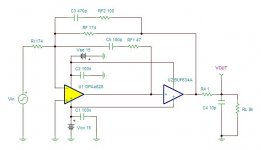You might want to take a look around pages 12-14 of the following and see what you think: http://www.cranesong.com/solaris_manual_version_1.pdf
Already convinced 10Hz is critical, myself. Amazingly or not, Allo Katana dac has lower measured jitter than Benchmark DAC-3 (according to ASR), and DAC-3 and Crane Song Solaris are said to sound very similar to one another. Solaris uses an AKM dac chip, and DAC-3 uses ESS. But they both use SRC4392 clocked at 27MHz to reduce jitter by upsampling, and then use external interpolation filtering.
They don't reduce jitter by upsampling per se.
The jitter is reduced by the digital PLL in ASRC. Jitter above a certain freq is
rejected. Jitter below that freq is permanently encoded into the ASRC's OP.
The jitter rejection curves are shown on P34, fig 73 and 74. So clearly,
SRC4392 has very good jitter rejection down to very low frequencies.
The reason they run 27MHz is likely more than they are letting on.
B Putzeys, years ago, did some investigation into these ASRC parts and
uncovered some interesting anomalies. From memory, that when IP SR
equals or is very close to OP SR, they can produce jitter spurs. The solution
was to shift the OP SR above max IP SR of 192 / clock freq above
24.567MHz. 27MHz serves this well, whilst a/ staying within max freq of
part, b/ is pretty commonly used clock freq c/ is still low enough to source
very low LF phase noise clocks.
Solaris doesn't use SRC4392 as they state it's a 32 bit part. I'd say the
reason Benchmark stuck with the TI 24 bit ASRC is it probably has better
jitter rejection than the others, of which there is no information available.
T
Sure. But, the higher we upsample, typically the 'better' and less distorted it sounds. Bottom line is we usually reap benefits from both upsampling and conversion to native DSD. Why does DSD sound better? It looks like the low-ish cost interpolation filtering DSP built into dac chips sounds better with DSD, presumably given that the filtering requirements are simpler than for PCM. With external interpolation filtering PCM filter sound quality can be improved to sound as good as (or maybe even better than) DSD filtering, a reasonably wide transition band can simplify high quality filter design for sample rates not exceeding 192kHz (if upsampling is to 211kHz), and distortion due to intersample overs can be dealt with in way that minimizes or eliminates any distortion from over events.
Last edited:
Just tested ok master clock source. Dual frequency Si546 vcxo, adm7150, PMLCaps. 200fs jitter.
Still missing 10 oms output resistors.
Have upgraded the clock.
Unfortunately, DSD still has a little cracks/pops at changing the track or play position. Compared to original clock the cracks are definitely shorter. It is same with PCM->DSD conversion, hereafter I guess the problem is not with digital receiver (and/or AK4137), but with DAC itself.
If you have some experience with DSD on Amanero->AK4137->AKMs, please, suggest what else to check?

Thanks a lot!
Hi nemantree,
No need for a buffered I/V opamp for AK4499. Each dac channel has to have its own pair of I/V opamps, eight I/V opamps in total, and AKM has chosen to use exactly the same opamp ESS uses: OP1612. Its probably the best opamp for the application as it is known that it can be used successfully with the ESS hump removal Vref offset trick. Same trick helps sound quality with AK4499 too, as it turns out. Actually, my guess would be that it reduces distortion in the differential summing stage (which these dacs need to use to provide single-ended outputs, and to complete output stage LP filtering).
No need for a buffered I/V opamp for AK4499. Each dac channel has to have its own pair of I/V opamps, eight I/V opamps in total, and AKM has chosen to use exactly the same opamp ESS uses: OP1612. Its probably the best opamp for the application as it is known that it can be used successfully with the ESS hump removal Vref offset trick. Same trick helps sound quality with AK4499 too, as it turns out. Actually, my guess would be that it reduces distortion in the differential summing stage (which these dacs need to use to provide single-ended outputs, and to complete output stage LP filtering).
Last edited:
- Status
- This old topic is closed. If you want to reopen this topic, contact a moderator using the "Report Post" button.
